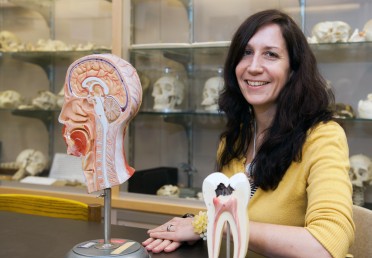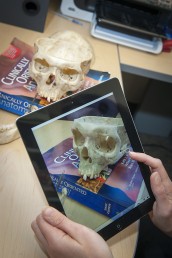Anatomy lab? There’s an app for that

Alison Doubleday uses iPads as a teaching tool in anatomy. Photo: Roberta Dupuis-Devlin/UIC Photo Services (click on image for larger file size)
With the revolution created by tablet computers, it’s no surprise to find them in schools and universities across the country.
Now they’re being used in a more unlikely place: the anatomy lab.
Alison Doubleday, assistant professor of oral biology in the College of Dentistry, incorporated iPads into her course with funding from UIC’s Council for Excellence in Teaching and Learning.
“If we find a way to integrate an activity that’s complementary, that allows me to see what everyone’s doing; I can get a sense of what they’re having trouble with,” Doubleday said.
She used a $9,000 grant to purchase 15 iPads, and with advice from the UIC Innovation Center, set up two software applications to help her students learn, then share their learning.
Doubleday obtained a free one-year trial from dScout, an app designed as a market research tool, and worked with the company to adapt it for her course.
The students are given a list of items to photograph during their lab work. They use the app to take the picture, then answer questions about the material, with Doubleday reviewing their answers. The pictures are uploaded for others in class.
“I’ve been looking for a way to use learner-generated content in the lab,” said Doubleday. “That idea sort of stimulated the whole project.”
Doubleday’s students use a file-sharing app, Box, to share video journals of their work for their classmates to view and comment on.
“My motivation behind this was to see what my students were doing when I’m not around,” she said.
“Just to see what they’re learning — how they’re starting to think about the information.”
Bringing this type of technology into the anatomy lab poses sensitive issues of security and ethics that Doubleday addresses with her students.
“I had to make sure we were doing this in a way that everything was very secure, password-protected,” she said. “We had to do this in a proper and regulated manner.”
After using the new technology for two semesters, Doubleday is compiling feedback and working on a paper that analyzes the data and suggests future uses.
She said she will use student responses from last year to improve next year’s instruction.

